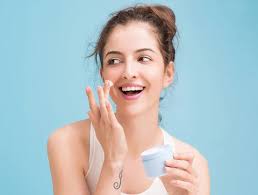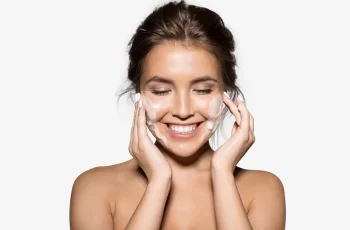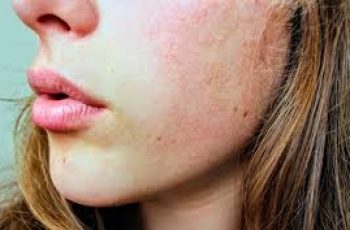Can you Use Retinol with Rosacea?
Finding a skincare routine at the best of times can be tricky, let alone when you prone to flare-ups in rosacea. It can often feel like an impossible task finding ingredients that can keep your complexion looking and feeling its best. With that in mind, I wouldn’t blame you for scratching your head with slight confusion when you hear how using retinol can help combat rosacea. Yes, admittedly it doesn’t really add up using one of the most potent skincare ingredients topically on a skin that is suffering from rosacea, known for making your skin feel tight, dry, and uncomfortable.
Don’t worry though as we will make everything a lot clearer by the end of today’s blog post, so stick around if you want to know whether you can use retinol with rosacea.
Will retinol make rosacea worse?
The short answer is no, it won’t, even though common belief and misunderstanding of how retinol works may make you feel it is a recipe for disaster. Quite often many think retinol exfoliates the skin when in fact it increases the speed of the skin cell cycle, pushing away the build-up of dead skin cells and revealing fresh, vibrant skin giving you a glowing complexion. This is why using retinol with rosacea will benefit the areas suffering from inflammation as they will be significantly reduced. Having said that, if your skin is particularly sensitive it is best to consult with a doctor or dermatologist to ensure you are using the correct concentrate that will benefit the skin and prevent any unwanted reactions.
Can you use retinol cream on rosacea?
Yes, you can, so long as you have checked with a dermatologist or medical professional that it is safe to do so. As I have already mentioned, by applying a topical cream or lotion containing retinol you are able to reduce any inflammation or flare-up of rosacea. To help combat any further potential severe dryness, team your retinol cream by applying a serum beforehand packed with hyaluronic acid and other hydrating and skin-repairing ingredients.
One important point to remember with retinol is that it must be introduced in the correct way. You do this by starting with one application a week during your evening routine, you then need to allow the skin to build tolerance and work your way up to every other evening. If this is new information for you and you’re finding retinol a little confusing to understand you can check out our dedicated blog post about the skincare benefits of retinol.
What retinol is best for rosacea?
When you first start using retinol to combat rosacea flare-ups it is advisable to use formulas that are available over the counter. The reason for this is because the percentage of retinoid used in the product is lower than the other more potent formulas that are medical grade or prescription only.
Try to find formulas that are light-weight and are in a serum or oil consistency especially if there are other hydrating ingredients included in the blend as this will not only help calm the inflammation of the skin surface, but you will also ensure the protective skin barrier is strengthened with the correct levels of water. The reason this is important is because when the skin barrier is weakened skin damage caused by exposure to free radicals, such as pollution, central heating and UV rays will result in signs of ageing, uneven skin tone and loss of elasticity.
What should you not use on your face if you have rosacea?
There are several skincare ingredients that should be avoided when you are prone to rosacea flare-ups. Here are examples of the worst ingredients that should not be used:
Glycolic acid
Lactic acid
Alcohol
Fragrance
You’ll find that these ingredients are often found in skincare products such as toners, astringents, and cleansers. To avoid aggravating the problem the best thing to do is to never use toners and switch to cleansers that are gentle and non-foaming.
How do you calm down a rosacea flare-up?
If you find you are suffering from a rosacea flare-up here are some of the easiest and most effective steps to take to help combat the inflammation and soothe irritated skin.
Switch to a gentle cleanser- Ensure you are using lukewarm water and massage the cleanser onto your skin very carefully. Once you have finished dry the skin by using a soft towel and patting gently.
Moisturise daily- In fact, moisturise twice a day to ensure you are maintaining effective skin health, especially if you opt for a formulation that is packed with hyaluronic acid and other hydrating ingredients.
Avoid using harsh products- Even the gentlest formulas of face scrubs will be too much for the skin. Therefore, you should avoid using products, such as face scrubs and exfoliating toners.
Use sun protection every day- Even days that are gloomy and overcast it is still very important to use a daily SPF. This will protect the skin from exposure to UVB and UVA rays as well as other environmental aggressors and free radicals.
Test your makeup before applying it to the face- Quite often you’ll find that makeup formulas contain a lot of fragrance which can cause rosacea to worsen. Before applying any foundations or any makeup test it by dabbing a small amount next to the inflamed area of skin. If there are no signs of the rosacea becoming worse, you are safe to apply the makeup to your face.
How long do the retinol uglies last?
The retinol uglies are a term used by many to describe the side effects of applying retinol to the skin for the first time. When building the skin’s tolerance, you’ll find there are areas of flaky patches of skin, slight redness, itchiness, and the skin will feel dry and uncomfortable. There is no escaping the uglies and it is considered something that you just must wait out, some find they last a week, some closer to three weeks. You can help combat and soothe any areas with hyaluronic acid to give the skin a boost in hydration.
There you have a little information about using retinol when you have rosacea, don’t forget if you have any concerns with using certain skincare products its best to consult with a doctor or dermatologist. For any other skincare related questions you can come and follow us on Instagram.
DQH Knowledge drop: In your 20s, your skin cell turnover decreases. (Cell turnover is a key component in keeping your skin youthful.) You know what else slows down? Your collagen production. Starting in your 20s, collagen decreases by about 1 percent per year. Should you want to prevent fine lines and wrinkles, start by eliminating behaviors that contribute to premature aging. “If it’s bad for you, it’s bad for your skin,” says dermatologist Michel Somenek.
“Cigarette smoking reduces blood flow to the skin and causes premature wrinkling and a dull skin texture. Making the repeated pursed motion to inhale can also cause smoker’s lines. Alcohol and recreational drugs are toxins for the skin that damage its cellular structure and DNA,” Somenek tells us. “The faster you eliminate vices while you are young, the better chance your skin and body have to recuperate.” Also, adopting an anti-aging routine in your 20s is key. After all, the best offense is a good defense. We spoke to Somenek and experts Joshua Ross and Audrey Kunin to find out more.
Keep reading for the best anti-aging products for your 20s, according to skincare professionals.
Sunscreen
“We all know that the sun is the number one cause of skin aging and starting the prevention in your 20s is very important,” Ross says. “The majority of your sun damage won’t start to appear until you’re in your 30s, so don’t wait until you see it surface or you’ll be behind the curve. Stay ahead of it with a good-quality zinc-based sunscreen worn daily.”
Farmacy Green Defense Daily Mineral Sunscreen
An invisible sunscreen with SPF 30, plus botanical extracts meant to protect skin with tons of antioxidants. Bonus: It’s clean and fine to use under makeup.
Bareminerals Complexion Rescue™ Tinted Moisturizer Broad Spectrum SPF 30
Although we recommend you use your SPF and moisturizer separately, we also understand moments when you don’t have time or energy for that extra step. For those times, this bareMinerals moisturizer is a great thing to have on hand.
Vitamin C Serum
“A great introduction to anti-aging is to start with a vitamin C serum in your morning skincare routine,” Ross says. “It’s a powerful antioxidant that will neutralize free radicals and brighten the skin.” He adds that it’s a great way to counteract the effects of the sun’s harmful rays, which, as previously mentioned, are among the biggest causes of premature aging.
Drunk Elephant C-Firma™ Vitamin C Day Serum
The Drunk Elephant C-Firma is a lightweight serum that promises to give skin a glow by combining the brightening powers of vitamin C with ferulic acid, l-ascorbic acid, and vitamin E. The included sodium hyaluronate is meant to replace hydration loss, so you shouldn’t have to deal with any irritation.
Sunday Riley C.E.O. Rapid Flash Brightening Serum
This potent serum is jam-packed with vitamin C (15 percent, to be exact), which means it’s a potential superstar at both brightening skin and dousing it in antioxidants.
Peptides
Using peptides on your skin has many benefits, says Somenek. “The skin barrier is what defends the body against pollution, UV rays, bacteria, and toxins. It can be damaged by several everyday factors. Using topical peptides aids in building a stronger barrier,” he says. “Peptides comprise elastic fibers, which are a type of protein. These fibers help to make skin appear taut and firm. Peptides can also help repair damaged skin, relieve inflammation, and even out skin tone. Some peptides can kill acne-causing bacteria that is common in 20-somethings.”
Kunin agrees, saying, “Peptides are an excellent entry point for supporting collagen.” She recommends looking for face and eye treatments that contain these collagen-boosting powerhouses.
Charlotte Tilbury Magic Eye Rescue Cream
This Charlotte Tilbury super-emollient eye cream has a base of coconut oil and shea butter (read: it’s incredibly hydrating). Botanicals plus peptides are meant to help reduce dark circles and boost collagen, respectively.
This creamy moisturizer serves up potent collagen-boosting peptides and pycnogenol, and antioxidant-rich vitamin C. “Instead of sitting on top of the skin, peptides penetrate the outer layer so they go deep. The ‘signals’ they send tell the cells to produce elastin and collagen, which are needed for youthful-looking skin,” explains Somenek.
At-Home Peel Pads
Remember that skin cell turnover fiasco we talked about earlier? One way to help support it is by exfoliating. “Exfoliation is important to help keep skin fresh and luminous,” Kunin says. She recommends using at-home peel pads as an easy and effective way to exfoliate.
“The goal in your 20s is to fight the slowing pace of cell turnover. It is wise to use products that gently exfoliate, yet still remove oil and other impurities. Products that have Alpha Hydroxy Acids (AHA) or Beta Hydroxy Acids (BHA) are a good choice.”
According to Somenek, you should only exfoliate two to three times a week. “People of all ages are guilty of over-exfoliating and that can be too much of a good thing,” he says.
Dermadoctor Kakadu C Intensive Vitamin C Peel Pad
A few swipes of this Derma Doctor powerful peel pad promise to leave your skin glowing and smooth, thanks to the seven (yes, seven) types of chemical exfoliants, including AHA and BHA. It also contains vitamin C via Kakadu plum extract for added brightening and antioxidant protection.
KEY INGREDIENTS Kakadu plum extract is sourced from the Kakadu plum, a fruit grown in northern Australia. It contains vitamin C, which restores the skin’s natural barrier, increases collagen production, and soothes irritation.
Dr. Dennis Gross Skincare Alpha Beta® Universal Daily Peel Pads
These are the gold standard of peel pads, with a cult following and over 900 five-star reviews on Sephora. They’re easy to use and contain a blend of anti-aging exfoliating acids.
Emollient Night Cream
“In your 20s, you need to start upping the hydration in your skincare routine. You may have been cautious of over-moisturizing because of acne in your teens, but as you enter your 20s, your skin transitions and becomes drier,” Ross says. “I recommend an emollient night cream added into your evening skincare regimen.”
“Twenty-somethings need to make sure that they are not using creams that will clog their pores and cause excess oil production,” says Somenek. Opt for non-comedogenic products.
Cerave Skin Renewing Night Cream
One great choice is the CeraVe Skin Renewing Night Cream, which is a non-comedogenic night cream that leaves skin soft and glowy. It combines the moisturizing powers of ceramides and hyaluronic acid.
RoC Retinol Correxion Max Hydration Creme
“The best night cream ingredients contain retinol, benzoyl peroxide, and/or salicylic acid or hyaluronic acid. The goal is to moisturize, yet remove excess oil,” says Somenek. This Roc Retinol Correxion cream fits the bill as it contains both hyaluronic acid and retinol so it promises to moisturize while also being non-comedogenic.



